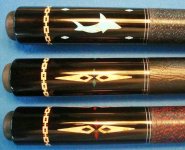With some invaluable advice from a few select people on here, I built my machine last winter. THK ball slides, Ø3/4 Kerk screws with zero backlash nuts.
http://www.timocues.com/CNC/Inlay machine1.wmv
I jogged about 18” down my X and ran the same program. Same results but maybe not as severe of an X shift. And yea Jim the bottom of the skull is also shifted like the top. I let the machine sit a few hours, then rotated the skull 90º in Autocad. Sorry I’ve been on Autocad for 20+ years so why fight it. I brought it into Bobcad and regenerated the exact same program settings. IT CUT PERFECT. Last I brought in my original Autocad skull and remade the program fresh. IT SCREWED UP AGAIN. What does this mean. I’ll tell you what this means. I have know freakin idea what this means but I can’t turn my cue 90º. :smile:
We had an issue at work on Tuesday. The posted code was not correct.
When the put it through a back plot program, saw that the cutter was on a path not of the shape of the item.
It was reposted, checked and then was correct.No idea as to how the error occurred, not done it since or before.
You may be better to draw in Bobcad and see if there is any difference in the code.
On one of the machines, if we have the feedrate too high, ie quicker than the machine is capable of accelerating, it does not make round holes or the shape is not correct.The holes can be up to .15mm out of round.
Now that we know this, the parts are programed so that the machine keeps up with the path in the feedrate.
So if programed at 1200 mm/min but the actual is flutuating in x,y to 800,450 the part will be wrong. When actual programmed is 1200 and x,y is 1150,1100 the part will be correct within what can be expected in milling.The smaller the detail , the slower we have to program, so a 4mm circular hole cut with a 3 mm cutter, can only cut at 100mm/m feedrate.
At this speed, the hole when indicated is within .01mm TIR
To get better than this requires a better machine with less backlash in the system. Even though it has 0.001 mm increments, the backlash cannot be set any finer than .002-.003mm.
Mass and rigidity of the machine come into play when you are looking at precision work.
Another test is to see if you get the same results climb milling as to conventional milling. Quite often there is a difference.If you know what works best for your situation,it becomes something to work with.
There are so many things that can be causing the problem apart from the mechanical backlash.
There is a whole range of interference that can also be contributing to the problems as well.
Nice video clip.Thanks

